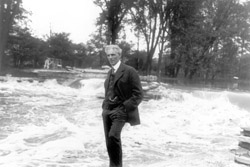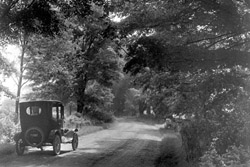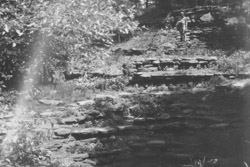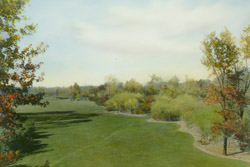| |
Henry and Clara Ford's Fair Lane estate in Dearborn, Michigan is one of the best surviving examples of celebrated landscape architect Jens Jensen's large-scale residential designs. Originally called in to solve a grading problem around the house, Jensen soon found that he and Henry Ford shared many interests. Both men had a strong commitment to preserving habitats for wildlife and both had strong conservation values. Jensen once told Henry and Clara Ford that he would put the land back to what it was when the American Indians skied down the banks of the Rouge River.
The naturalistic master plan that Jens Jensen created for the Fords' Fair Lane estate included most of his signature elements—a path to the setting sun down a great meadow, a series of networked garden rooms, a quiet lagoon, a rock garden with waterfall and pool, a grotto and bird pool, a blue garden, and various farm and orchard gardens.
Jens Jensen continued to design landscapes for the Ford family and Ford Motor Company for about twenty years. He designed the grounds of Henry Ford Hospital in Detroit, Michigan, the sites of numerous Ford Motor Company office buildings, and landscapes for four homes of Henry's son Edsel and his wife Eleanor. His office also provided plans for Greenfield Village, and the Ford pavilion at the 1934 Chicago Century of Progress.
-- Kathy Steiner, Head of Access Services
 |
|
 |
| Henry Ford wanted to use hydroelectricity to provide power for his Fair Lane estate. Here, Ford is shown standing on the banks of the Rouge River in front of a hydroelectric dam that Jensen camouflaged so carefully that it appeared to be natural rapids. This dam remains the most extensive of Jensen’s renowned river-edge rock creations. ID.P.833.5713 |
|
The entrance road to the Fair Lane estate was carefully designed to allow visitors to experience sequences of sun and shade–a Jensen trademark. ID.P.833.20311 |
| |
|
|
 |
|
 |
| The Burroughs Grotto was designed to attract birds and to celebrate Ford’s friendship with naturalist John Burroughs. It included a heated bird pool and rock garden, with a statue of Burroughs perched on a ledge. ID.P.O.19532 |
|
The Great Meadow at Fair Lane leads out from the terrace with a slight bend in its length. At the far end of the meadow is a small pond with a cluster of white birches on the edge of the woods. During the summer the early morning sun softly highlights these trees while the evening sun sets at the end of the path to the setting sun. ID.P.O.19118 |
|

